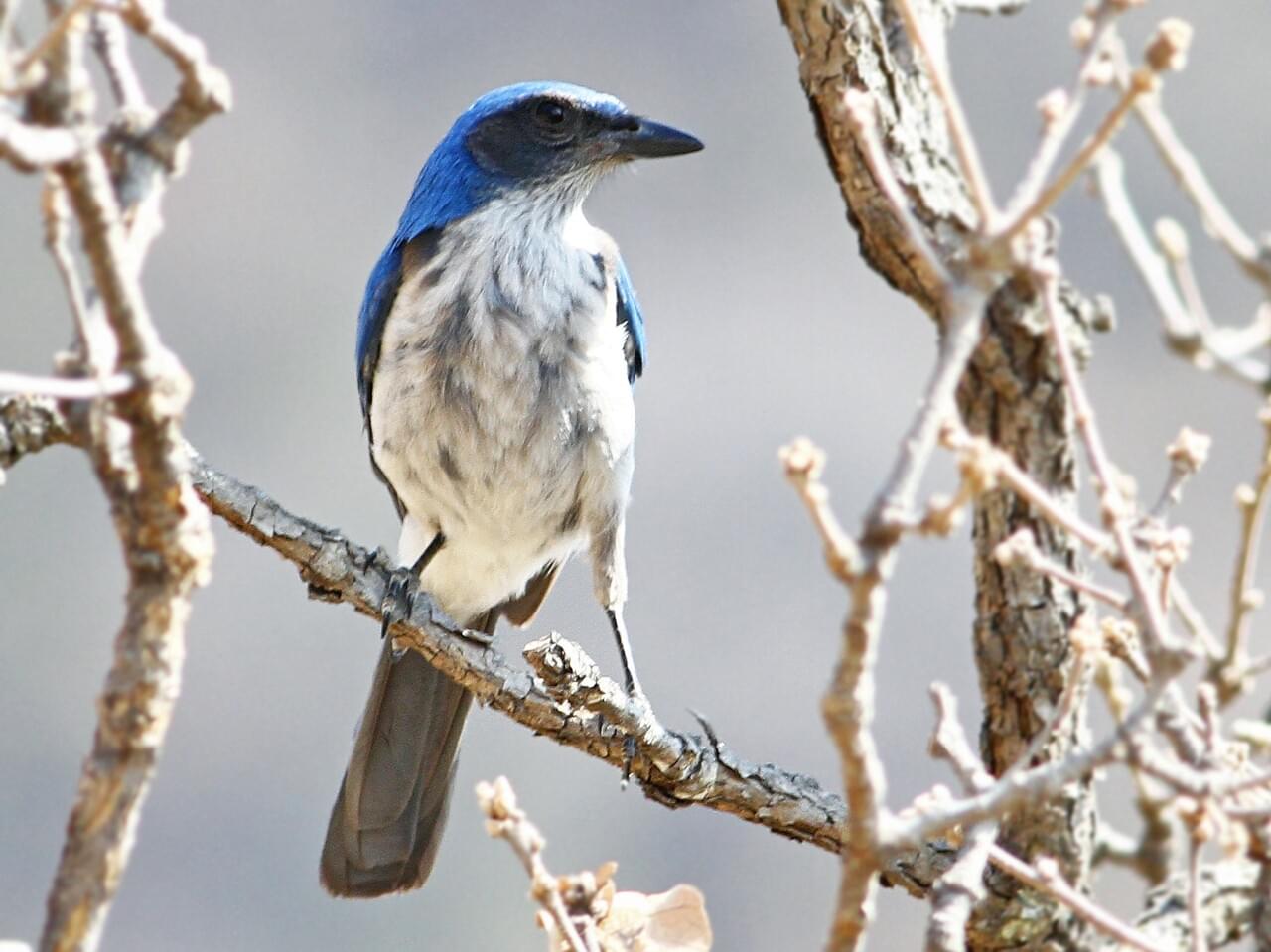 Photo ©
Kyle Matera / Macaulay Library
Photo ©
Kyle Matera / Macaulay Library
Woodhouse’s Scrub-Jay
Regional Species
The “blue jay” of dry lowlands from Nevada south to Mexico, Woodhouse's Scrub-Jay is a dusty blue bird set off by gray-brown and white. It looks very similar to the California Scrub-Jay (they were considered the same species until 2016), but it's a dimmer blue and dingier gray, with almost no necklace, a straighter bill, and higher-pitched calls. The bird's rounded, crestless head immediately sets it apart from Blue Jays and Steller’s Jays. These birds are a fixture of dry shrublands and woodlands of pinyon pine and juniper.
Range

Habitat
Woodhouse's Scrub-Jays live primarily in pinyon-juniper and oak-pinyon forests of the interior western United States. Less often, you may find them in stands of mountain mahogany, juniper stands, among trees and cactus along desert streams, or in the oak scrublands of Texas's Edwards Plateau. In Mexico they also live in palmetto and thorn scrub in Oaxaca and in pine-spruce forests at high elevations in the Sierra San Pedro Mártir. They also live around people and may appear in suburbs, golf courses, and parks.
Food
Woodhouse's Scrub-Jays eat mostly insects and fruit during spring and summer, and switch to nuts and seeds during fall and winter. They eat small animals such as lizards and nestling birds, sometimes finding nests by following the parent birds. For plant material, Woodhouse's Scrub-Jays eat pine nuts, juniper berries, and grass seeds; sunflower seeds and peanuts at feeders; as well as cultivated corn, almonds, walnuts, and cherries. The birds aren't able to break pine cones before they open, but their relatively thin, straight, pointed bill helps them reach in and extract the rich pine nuts as soon as a gap opens.
Behavior
Woodhouse's Scrub-Jays are animated birds that move about in bold hops and lunges, looking around with sharp turns of the head. Often found in flocks during winter, these birds are vocal and playful. Both members of a breeding pair staunchly defend their territory year-round, keeping other scrub-jays away by flying at them, calling, and occasionally pecking or grappling. Pairs stay together throughout the year and often feed each other, particularly during the breeding season. The female does all the incubation. In Oaxaca, Mexico, the subspecies known as "Sumichrast's" scrub-jay breeds cooperatively, with previously fledged birds remaining on their parents' territory and helping raise additional broods (similar to the Florida Scrub-Jay). During the nonbreeding season, flocks of birds that lack territories of their own (known as "floaters") form and may move away from breeding habitats. Nest predators include raccoons, weasels, skunks, squirrels, king snakes, gopher snakes, rattlesnakes, magpies, crows, and jays. Predators of adults and fledglings include bobcats, house cats, accipiters, and Great Horned Owls.
Nesting
Scrub-jay nests are made of a basket of twigs lined with rootlets, fine strands of plant fibers, and livestock hair. Nests take about 12 days to build and are about 6 inches (15 centimeters) across when finished. Both members of a pair help with building.
Appearance
Typical Sound

© Andrew Spencer / Macaulay Library
Plumage Photos
Similar Species
California Scrub-Jay overlaps with Woodhouse's only in a limited part of eastern California and western Nevada. California is a deeper, richer blue with brighter gray-white underparts and a much more distinct blue necklace. Pinyon Jay is the only other large blue bird without a crest that you're likely to see in most of the western United States. Pinyon Jays are stockier, shorter-tailed (almost crow-shaped) and plainer blue overall. If you live in Central Florida and think you've seen this species, you've seen the very similar but much less numerous Florida Scrub-Jay. (Another species, the Island Scrub-Jay, lives only on Santa Cruz Island, southern California.) If your blue bird has a black crest, it's a Steller's Jay; if the crest is blue you have a Blue Jay. Western Bluebirds and Lazuli Buntings are also blue, but are much smaller, with shorter legs, bill, and tail. The Mexican Jay of far southern Arizona and New Mexico has an all-blue back and lacks the scrub-jay's necklace.
Did you know?!
- Scrub-jays of the West evolved in two very different habitats: oak woodlands and montane pinyon pine stands. Woodhouse's Scrub-Jays live mainly among pinyon pine trees. They developed relatively thin, pointed bills that are adept at getting at the pine nuts hidden between pine cone scales. California Scrub-Jays live around oak trees and have developed stouter, more hooked bills that help them hammer open acorns.
- Woodhouse's Scrub-Jays have a mischievous streak, and they’re not above outright theft. They’ve been caught stealing acorns seeds and pine cones from Clark’s Nutcrackers.
- You might see Woodhouse's Scrub-Jays standing on the back of a mule deer. They’re picking off and eating ticks and other parasites. The deer seem to appreciate the help, often standing still and holding up their ears to give the jays access.






